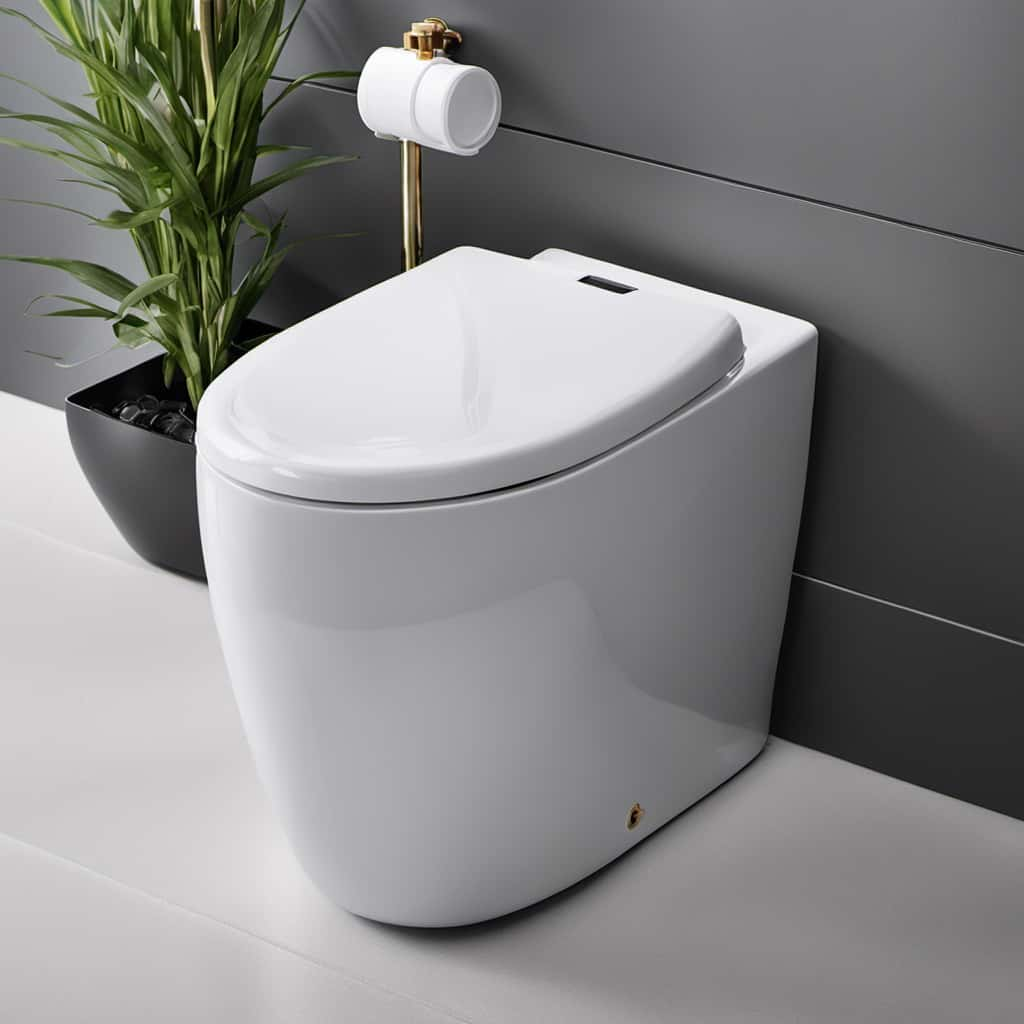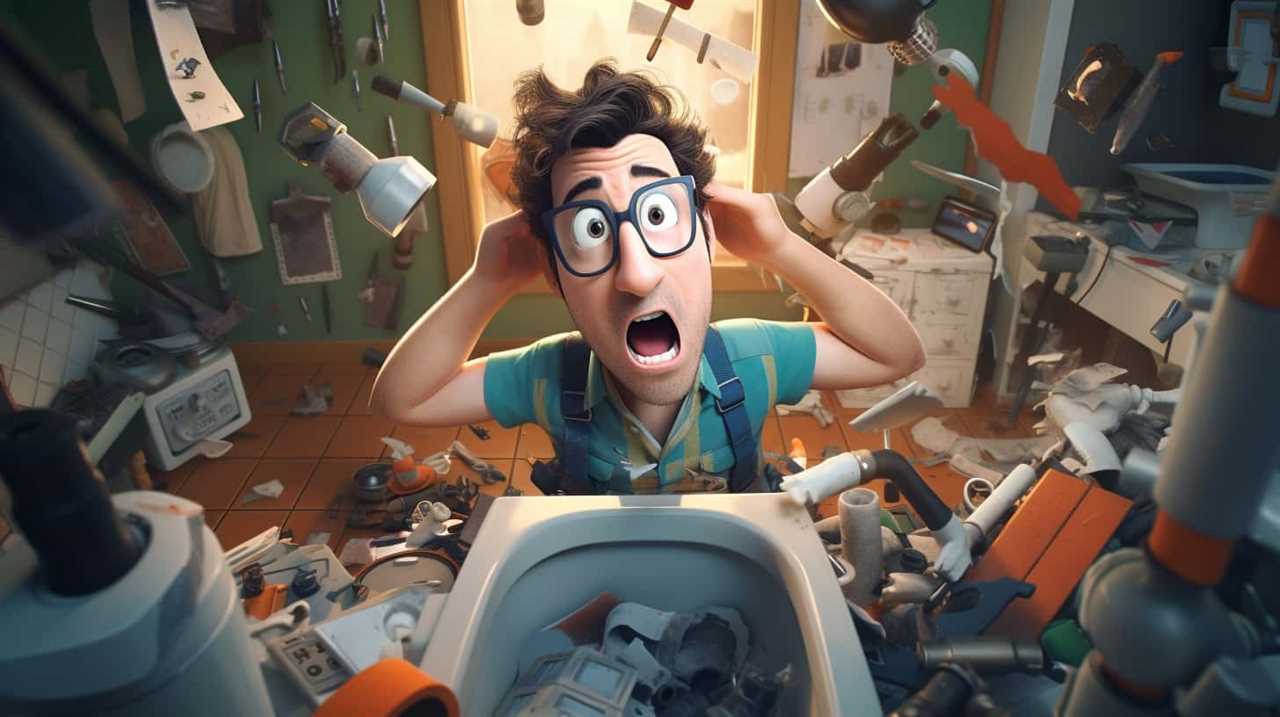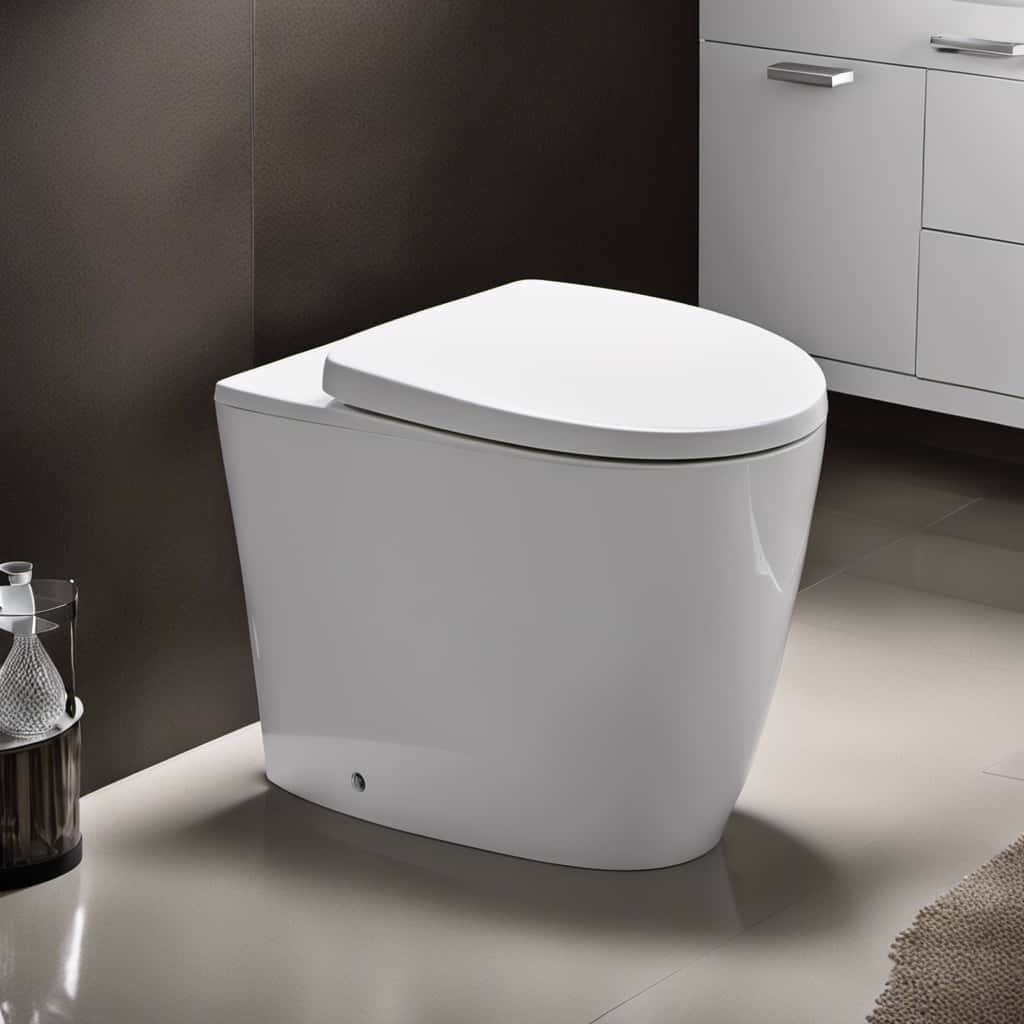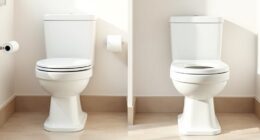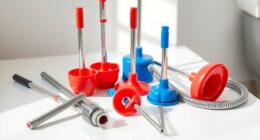Hey there! Having a clogged toilet can be a real pain in the you-know-what. But fear not, because I’ve got you covered with some expert advice on how to handle this messy situation.
In this article, we’ll go through a step-by-step guide on what to do if your toilet gets clogged. From assessing the severity of the clog to using the right tools and even preventative measures, we’ll cover it all.
So let’s plunge into it and get your toilet back in tip-top shape!
Key Takeaways
- Check for rapidly rising water level in the toilet bowl.
- Determine if the water is draining slowly.
- Inspect the toilet bowl for visible blockages or debris.
- Consider using a plunger or a toilet auger to clear the clog.
Assess the Severity of the Clog
You should first determine how severe the clog is by checking if the water level in the toilet bowl is rising or if it is draining slowly. Assessing the severity of the clog is crucial in order to determine the appropriate course of action.
If the water level is rising rapidly, it indicates a more severe clog that requires immediate attention. On the other hand, if the water is draining slowly, it suggests a partial clog that may be easier to clear.
Once you have assessed the severity of the clog, you can move on to determining the cause. This involves inspecting the toilet bowl for any visible blockages or debris that may be causing the clog.
Gather Necessary Tools and Supplies
First, make sure you have all the necessary tools and supplies on hand. When dealing with a clogged toilet, it’s important to consider whether you want to tackle the issue yourself or seek professional help. DIY can save you money, but it’s crucial to take safety precautions into account.
Here are three essential tools and supplies you’ll need for a DIY approach:
- Plunger: A plunger is the go-to tool for clearing toilet clogs. Make sure you have a high-quality plunger with a flange for better suction.
- Rubber Gloves: Protect your hands from potential mess and bacteria by wearing rubber gloves. This will also prevent any chemical irritations.
- Bucket: Keep a bucket nearby to catch any overflowing water or debris. It’s an essential item to prevent further damage.
Attempt to Clear the Clog Using a Plunger
Next, grab the plunger and position it over the toilet drain. This is a crucial step in attempting to clear a clogged toilet. Plungers are simple yet effective tools that can help dislodge the blockage and restore proper flow. To effectively use a plunger, follow these techniques:
| Plunger Techniques |
|---|
| Create a Seal |
| Push and Pull |
| Repeat as Needed |
Before beginning the plunging process, it is important to understand the common causes of a clogged toilet. These can include excessive toilet paper usage, flushing non-flushable items like wipes or feminine hygiene products, or a buildup of waste and debris over time. By knowing the cause, you can better assess the severity of the clog and determine the best approach for clearing it. Remember to exercise patience and persistence when using the plunger, as it may take several attempts to fully clear the clog.
Use a Toilet Auger or Snake to Break up the Clog
When it comes to tackling a stubborn clog in your toilet, you may find yourself torn between two options: using a plunger or a toilet auger.
Both tools have their merits, but it’s important to understand the key differences before making a decision.
While a plunger can often do the trick for minor clogs, a toilet auger, also known as a snake, is a more powerful and effective tool for breaking up stubborn clogs deep within the pipes.
However, if you’re not confident in your DIY skills or the clog persists despite your efforts, it may be wise to seek professional help to avoid causing further damage to your plumbing system.
Plunger Vs. Toilet Auger
To unclog a toilet, you can choose between using a plunger or a toilet auger. Both tools are effective in clearing stubborn clogs, but understanding their differences and knowing when to use them is crucial. Here is a breakdown of the pros and cons of each option:
- Plunger maintenance:
- Regularly clean and sanitize the plunger to prevent the spread of bacteria.
- Check for any damages or deformities in the rubber cup and handle.
- Store the plunger in a clean and dry area to avoid mold growth.
- Choosing the right toilet auger:
- Consider the length of the auger to ensure it can reach the clog effectively.
- Opt for an auger with a flexible cable to maneuver through bends and traps.
- Look for an auger with a durable and easy-to-use handle for better control.
With these considerations in mind, you can confidently decide which tool is best suited for your clogged toilet. Now, let’s explore the next topic of DIY vs. professional help…
DIY Vs. Professional Help
After weighing the pros and cons of using a plunger or a toilet auger, the next consideration is whether to attempt a DIY fix or seek professional help.
DIY success stories are not uncommon when it comes to unclogging toilets. Many people have successfully resolved the issue using simple tools and techniques found around the house. However, it is important to recognize the potential risks involved.
Without proper knowledge and experience, DIY attempts can exacerbate the problem, leading to more extensive damage and costly repairs. Additionally, certain clogs may require specialized equipment or expertise that only professionals possess.
If you are unsure about your abilities or the severity of the clog, it may be wise to seek professional help to avoid further complications. However, if you’re feeling confident, you can try using a natural or chemical drain cleaner.
Try Using a Natural or Chemical Drain Cleaner
When it comes to unclogging a drain, it’s important to consider the pros and cons of using natural versus chemical cleaners.
Natural cleaners, such as baking soda and vinegar, are often safer for the environment and can be effective for minor clogs.
However, for more stubborn clogs, chemical cleaners may be necessary, but caution must be taken as they can be harmful if not used properly.
In addition to these options, there are alternative unclogging methods, such as using a plunger or a drain snake, which can provide effective results without the use of cleaners.
Natural Vs. Chemical Cleaners
If you’re looking for an effective solution to unclog your toilet, consider the differences between natural and chemical cleaners.
Natural cleaners are often seen as a more eco-friendly option, as they don’t contain harsh chemicals that can harm the environment. However, their effectiveness may vary depending on the severity of the clog.
Chemical cleaners, on the other hand, are designed to break down tough clogs quickly and efficiently. While they may not be as environmentally friendly, they can be highly effective in unclogging toilets.
When choosing between natural and chemical cleaners, consider these factors:
- Effectiveness: Chemical cleaners are generally more effective at breaking down tough clogs compared to natural cleaners.
- Eco-friendliness: Natural cleaners are a more environmentally friendly option as they do not contain harsh chemicals.
- Safety: Chemical cleaners may pose health risks if mishandled, so proper precautions should be taken when using them.
Ultimately, the choice between natural and chemical cleaners will depend on your priorities, the severity of the clog, and your willingness to use potentially harsh chemicals.
Safety Precautions to Consider
Now that we have discussed the pros and cons of natural and chemical cleaners for unclogging toilets, it is important to address the safety precautions that should be taken when dealing with a clogged toilet.
When attempting to unclog a toilet, it is crucial to prioritize safety to avoid any potential accidents or injuries. Firstly, always wear rubber gloves to protect your hands from coming into direct contact with any bacteria or germs.
Additionally, make sure to keep a plunger handy, as it is a safe and effective tool for unclogging toilets. Avoid using excessive force, as this can lead to damage to the toilet bowl or pipe.
If the clog persists, it is best to contact a professional plumber to avoid any further complications or risks. By following these safety precautions and prevention tips, you can effectively deal with a clogged toilet while minimizing any potential hazards.
Alternative Unclogging Methods
One effective way to unclog a toilet without using harsh chemicals is by using a mixture of baking soda and vinegar. This eco-friendly method is not only safe for your pipes but also prevents future toilet clogs.
Here’s how you can do it:
- Measure half a cup of baking soda and pour it into the toilet bowl.
- Follow it with one cup of vinegar and let the mixture sit for about 30 minutes.
- Flush the toilet, and the combination of baking soda and vinegar should help break down the clog.
By using this natural method, you can avoid exposing yourself to harmful chemicals while effectively unclogging your toilet.
However, if the clog persists or if you’re unsure about handling the issue yourself, it’s important to consider calling a professional plumber for assistance.
Consider Calling a Professional Plumber
You should definitely consider calling a professional plumber if you can’t unclog the toilet yourself. While there are various unclogging methods you can try, sometimes the clog can be too stubborn or complex for DIY solutions.
A plumber has the expertise and specialized tools necessary to diagnose and resolve the issue effectively. They can assess the severity of the clog and determine the best course of action, whether it involves using a drain snake, hydro jetting, or even removing the toilet for further inspection.
Hiring a professional plumber not only saves you time and effort but also ensures that the problem is resolved correctly, minimizing the risk of further damage or recurring clogs. With their assistance, you can have peace of mind knowing that your toilet will be functioning properly once again.
To prevent future clogs, it is important to implement proper toilet maintenance practices.
Prevent Future Clogs With Proper Toilet Maintenance
To prevent future clogs, it’s important to regularly maintain your toilet. Here are some toilet maintenance tips to keep your toilet running smoothly:
- Watch what you flush: Avoid flushing items that can cause clogs, such as sanitary products, wipes, or excessive toilet paper. Only flush human waste and toilet paper.
- Use a plunger: Keep a plunger handy in case of minor clogs. Apply firm and steady pressure to create suction and dislodge the blockage.
- Regular cleaning: Clean your toilet bowl and tank regularly to prevent the buildup of mineral deposits and bacteria. Use a toilet brush and a mild cleaner to scrub away any stains or residue.
Common causes of toilet clogs include flushing inappropriate items, excessive toilet paper usage, and mineral buildup. By following these maintenance tips, you can avoid future clogs and keep your toilet functioning properly.
Conclusion
Well, there you have it! Dealing with a clogged toilet can be a real pain in the you-know-what, but fear not, for I have armed you with the knowledge and tools to conquer this unsightly beast.
Remember, a plunger is your trusty sidekick in this battle, but don’t hesitate to bring in the big guns like a toilet auger or snake if needed.
And hey, if all else fails, don’t be afraid to call in the professionals. Just remember to keep up with proper toilet maintenance to avoid future clogs.
Happy plunging!

